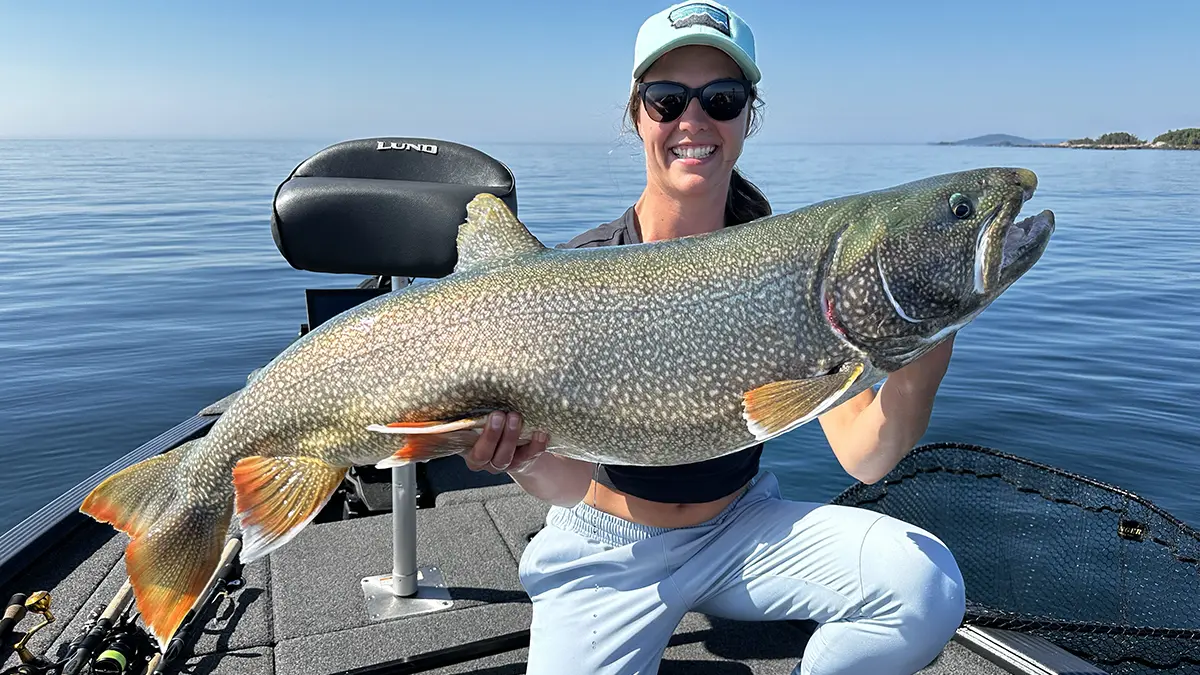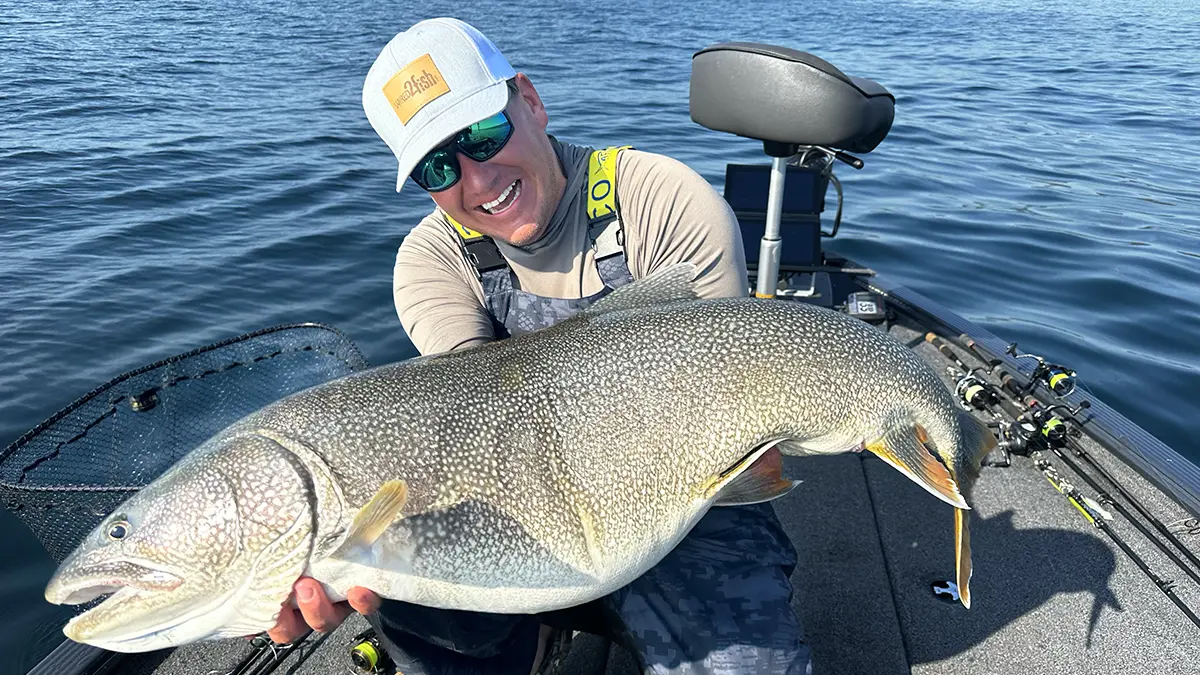Warning: Undefined variable $k in /home/nginx/domains/wired2fishcom.bigscoots-staging.com/public/wp-content/themes/understrap-child-0.6.0/functions.php on line 984
Warning: Undefined variable $k in /home/nginx/domains/wired2fishcom.bigscoots-staging.com/public/wp-content/themes/understrap-child-0.6.0/functions.php on line 987
As the flag laid limp and the streetlights beamed over an empty boat ramp parking lot, I knew we were in for a good day of fishing. The skies were just turning pink as the sun started to rise, and we were off. We tore five miles down the lake to a staging flat, where the lake trout bite at daybreak can be epic.
A ball of bait with several arches below it appeared on the 2D sonar after a few quick passes over the flat. We quickly dropped the trolling motor to hold our position, and all three anglers onboard hooked up within minutes of our jigs nearing the bottom. Drag peeled off all the reels as we ducked around and under each other while the fish pulled us around the boat. Three scoops of the net resulted in three beautiful lake trout in the boat.
For the next hour and a half, it was all out mayhem. Jigs were getting bit as fast as you could get them to the bottom. This is the appeal of vertical jigging for lake trout—it might just be the closest you can get to saltwater fishing on the sweet side of things, with fast action from powerful fish.

THE WHY
For the most part, people either love lake trout or hate them. Known for their slimy coat and aggression towards baits, they offer an amazing fight and if taken care of properly, make some of the best table fare. A member of the char family and not a true “trout,” lakers inhabit many deep, clear northern waters, like New York’s Finger Lakes where I reside. (Editor’s note: Lake trout seem to have a much sweeter flavor in the Finger Lakes than they do elsewhere. The ones I’ve eaten from the Great Lakes weren’t as good and seemed greasier. —JA)
As a cold-water fish, lake trout tend to stay deep most of the year, but will move shallow to spawn and feed during small windows. Traditionally, trolling was thought of as the most effective way to catch lakers because you can cover so much water. However, jigging can be more productive if you can land on the right school of fish or baitfish. Plus jigging is more fun, as you can use lighter tackle and it’s much more exciting than watching a rod tip as you drive in circles.

THE HOW
When trying to find lake trout, I look for steep drop-offs adjacent to flats. Those flats seem to be where bait stages. When I say bait, I’m talking about alewife, a lake trout’s favorite food! Alewife usually school up in masses and sit suspended in the water column. Lake trout will usually lay beneath them on the bottom then shoot up to grab an easy meal out of the bait ball.
Depending on the time of year, lake trout can be feeding on bait as shallow as 20 or as deep as 200 feet. To find bait balls, I rely on my high-speed 2D CHIRP sonar. Having a crisp, clear image is critical to pick apart what is interference and what is fish at the depths lakers typically inhabit. I keep the boat moving at around 5 mph; this seems to be the ticket for the best, most accurate readings.
Once I spot the bait ball or mark fish on the bottom, I drop a waypoint. Then I’lll hop up on the trolling motor, spin the boat around and head back towards that waypoint to get baits down to the bottom. If you have forward-facing sonar it can come in handy here, as you can use it to spot bait or fish as you approach the waypoint, but odds are you will hook up just by jigging at the same depth as the bait once you get close.
Once someone is on, spot-locking right over where the hookup occurred is key. Lakers typically don’t travel alone, and there can be multiple fish that are eager to bite. You might only get a few, but sometimes a fishing trip can take a turn for the better and you can have 30 fish in the boat in no time. “One stop shopping” doesn’t happen often, but when it does it can make for a memorable day on the water.

THE JIGS
Bait selection is important. In many cases, you want something with a fast rate of fall to get down to the bottom and stand out from the crowd. As much as I like to imitate an alewife, sometimes getting a little more obnoxious with the color can help. Generally, I like to stick with three lure types to get bit: a 3/4- to 1-ounce blade bait, a large minnow-style bait on a heavy jighead, or a large boot-tail swimbait.
My go-to for most situations is a 3/4-ounce Fish Sense Binsky, in either a silver or blue chartreuse color. This blade bait can catch them in all conditions and through a variety of different water depths. It can be seen very well on FFS, and the unique head shape increases vibration and creates a large disturbance in the water, triggering a feeding, reaction or anger strike.
Swimbaits and a large soft plastic minnow also have their time and place. Usually, it’s when the fish aren’t as active, and it takes a little finessing to get them to bite. Baits such as a Keitech 3.8-inch Fat Swing Impact or a Strike King Z Too are my go-to choices to put on a heavy, 1–ounce-plus jighead. They have a slender profile to get down quickly plus have great action in the water. Once the bait hits the bottom, you want to make long sweeps up and let the bait sink back down. Nine times out of 10 they will hit it as it’s falling back down. Remember, you want to stand out from the crowd with color selection. Baitfish schemes will work, but whites, chartreuses and glow colors will stand out and trigger them into biting.
All these baits can be fished on a 6-foot, 6-inch to 7-foot medium-action spinning rod paired with a large arbor spinning reel and braided line. Braid is crucial to feeling those bites in deep water with its zero stretch. To prevent lines from breaking or hooks from pulling, always put a shock leader on the end of your braid to give yourself a little bit of stretch.

GO DEEP OR GO HOME
The biggest piece of advice I can give to anyone looking to vertical jig for lake trout is to not get discouraged if you can’t find fish right away. Just keep zigzagging around till you locate a pod of bait or fish. They will never be in the same spot twice because they are always chasing bait, but previously active spots can be good starting points as to finding them. So get out there and get after them. It’s the most fun you’re not having.












